|
~~ Book 1886070519 ~~
Croquis japonais

"Ama"
by G. Bigot, 1886
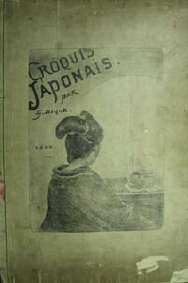 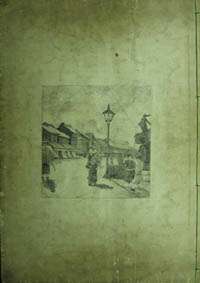
Condition. The 29 plates are in Very Good condition. The front and back covers, each with a tipped on etching, are in Poor condition. The plates show traces of waterstaining in the margin but none intrudes into the image area. The plates are clean and free of tears and well above average for this book. The binding of the book is solid and all string ties are in place. While the front and back covers have a vertical crease approximately one inch in from the edge, the paper is unbroken. These creases are the normal result of the book being opened. The covers are heavily soiled. The front cover has a 4 inch tear at the upper left which extends approximately one inch into the tipped on etching. The bottom right corner of the front cover is broken off (ca 1 x 1 1/2 inch) and there is a scraped area (ca 1 x 2 inch) at the bottom right. There are numerous small tears, abrasions and creases along the edges of the covers. There is evidence of removal of a bookplate on the inside of the front cover. The front blank free page has a manuscript inscription reading "Xmas 1892 from ??? 'g'."
Bigot, Georges:
Croquis japonais Par G. Bigot (Sketches of Japan), Tokio, 1886, small folio (12 1/2 x 18 in - 31.6 x 46 cm), paper wraps, string tied, a blank free page before and after the plates, 29 leaves/plates of black and white etchings printed directly on high quality thin cream laid paper. The front and back covers have black and white etchings laid/tipped onto thick gray cardboard covers. All of the 29 etchings on cream paper are in a recessed area as is characteristic of this printing process. The book is generally described as containing 31 etchings as the cover etchings are included in the total.
The image areas of the 29 etchings vary but, except for one, are generally 5 x 7 in or larger. The largest etching (Two Ladies Playing Shuttlecock/Badminton) is 8 x 10 in.
Georges Bigot's signature "G. Bigot" is found on 14 plates. A title is etched in manuscript on 18 of the plates.
This book went through several editions. I have seen a book with the same cover but with approximately 50% of the etchings with different images. The book is described as 33.5 x 26 cm. If this is the actual size it has either been reduced/cut down or it was printed in a smaller format. The images in this book can bee seen here. I have also seen the book with a different front cover which contains only Japanese language lettering.
Etching is a term of art that refers to an engraving process. It involves an artist actually sketching/carving the image onto a metal plate (usually copper) which has been coated with wax. The plate is dipped in acid and where the wax has been removed the lines are etched into the plate by the acid. It is quite likely that Bigot was the artist who sketched the plates rather than another person copying his work. On close examination, you see the printed image is in a recessed area. The recessed area is caused when the plate is pressed into the paper. It should be noted that not all of G. Bigot's books used the labor intensive etching process. Some employed the lithographic process which is more suited for mass production printing.
Bigot's life, with emphasis on the 20 years he spent in Japan, is discussed by Ikeda Tamio in "Georges Bigot's Passion for Japan" published in Daruma, Japanese Art & Antiques Magazine, Issue 35, Vol. 9, No. 3, Summer 2002. The author notes:
The first albums like Asa and O-ha-yo (1883) and Mata (1884) were limited to 150 copies and priced at two yen. These, especially Croquis japonais (Japanese Sketches) appearing in 1886 and several editions later, contributed to a renewal of engraving in the country. (Daruma 35, at page 41)
He worked in lithograph, including kage-e as in the second part of O-ha-yo....(Daruma 35 at page 41)
Croquis japonais
Details on the 31 Etchings
Title/ Signed/ Size/ Title Lettering [Subject]
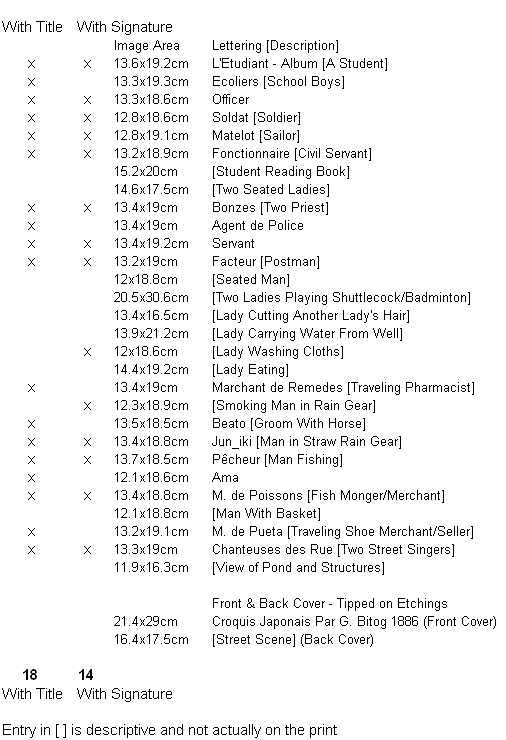
31 Etchings (29 plates and front and back covers)
Front Cover - Tipped on Etching
Croquis japonais Par G. Bigot, Tokio, 1886
21.4 x 29 cm
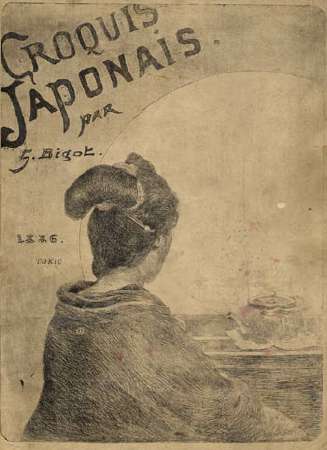
|
|
|
Plate 1
L'Etudiant - Album [A Student]
13.6 x 19.2 cm
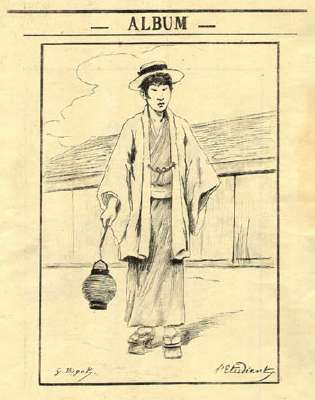
|
Plate 2
Ecoliers [School Boys]
13.3 x 19.3 cm
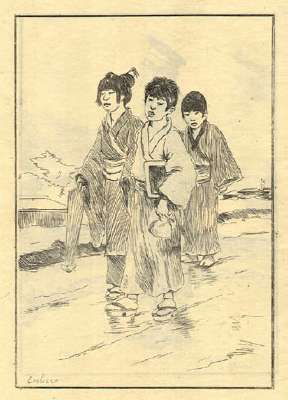
|
|
|
Plate 3
Officer
13.3 x 18.6 cm
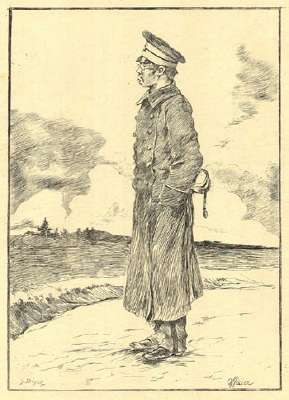
|
Plate 4
Soldat [Soldier]
12.8 x 18.6 cm
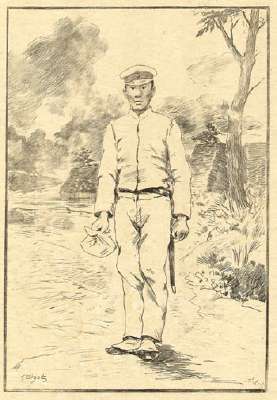
|
|
|
Plate 5
Matelot [Sailor]
12.8 x 19.1 cm

|
Plate 6
Fonctionnaire [Civil Servant]
13.2 x 18.9 cm

|
|
|
Plate 7
[Student Reading Book]
15.2 x 20 cm
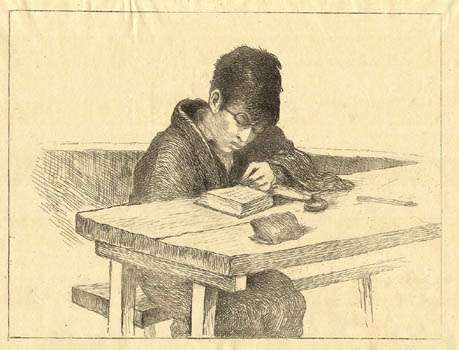
|
|
|
Plate 8
[Two Seated Ladies]
14.6 x 17.5 cm

|
Plate 9
Bonzes [Two Priest]
13.4 x 19 cm
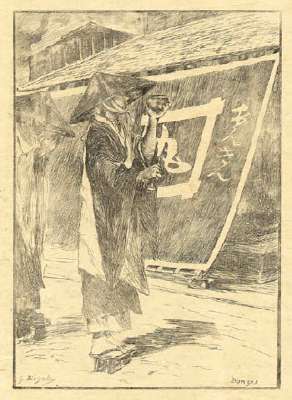
|
|
|
Plate 10
Agent de Police [Policeman]
13.4 x 19 cm
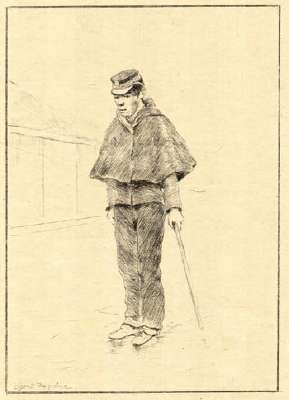
|
Plate 11
Servant
13.4 x 19.2 cm
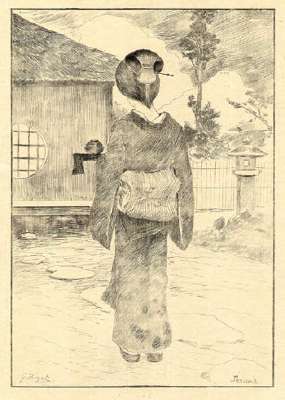
|
|
|
Plate 12
Facteur [Postman]
13.2 x 19cm
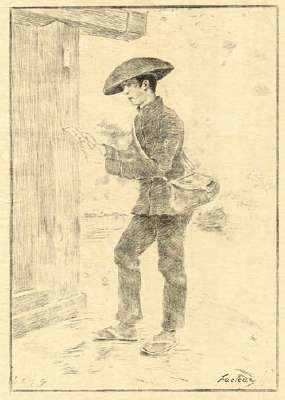
|
Plate 13
[Seated Man]
12 x 18.8 cm
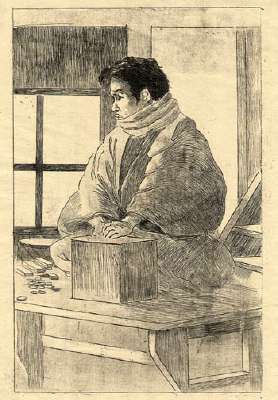
|
|
|
Plate 14
[Two Ladies Playing Shuttlecock/Badminton]
20.5 x 30.6 cm
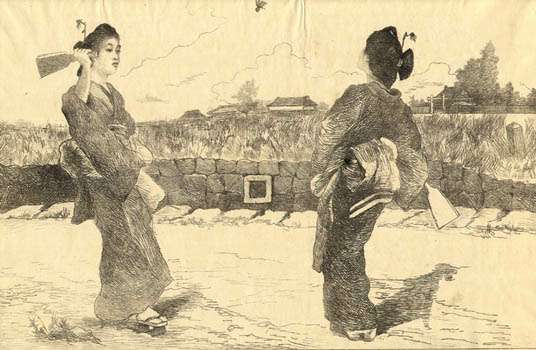
|
|
|
Plate 15
[Lady Cutting Another Lady's Hair]
13.4 x 16.5 cm
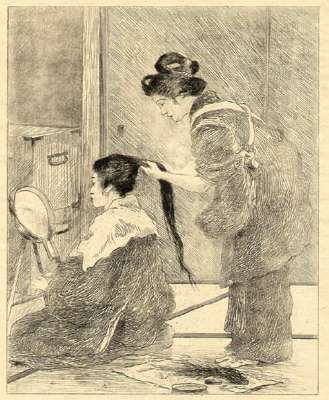
|
Plate 16
[Lady Carrying Water From Well]
13.9 x 21.2 cm
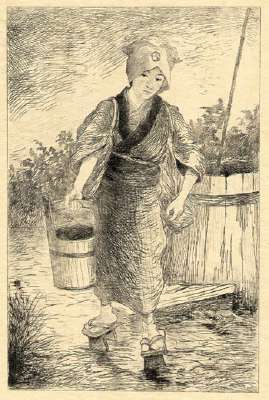
|
|
|
Plate 17
[Lady Washing Cloths]
12 x 18.6 cm
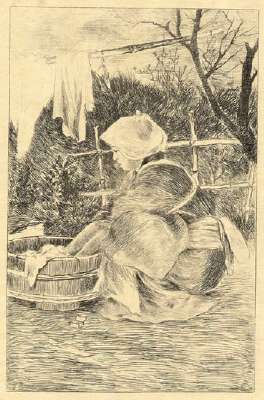
|
Plate 18
[Lady Eating]
14.4 x 19.2 cm

|
|
|
Plate 19
Merchant de Remedes [Traveling Pharmacist]
13.4 x 19 cm
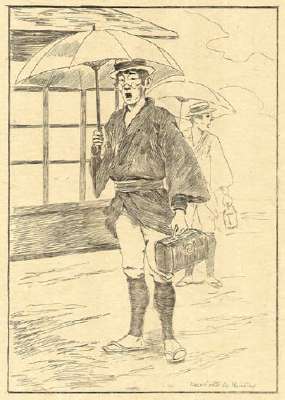
|
Plate 20
[Smoking Man in Rain Gear]
12.3 x 18.9 cm
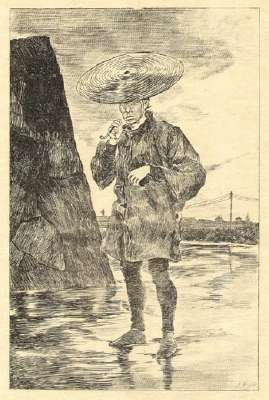
|
|
|
Plate 21
Beato [Groom With Horse]
13.5 x 18.5 cm
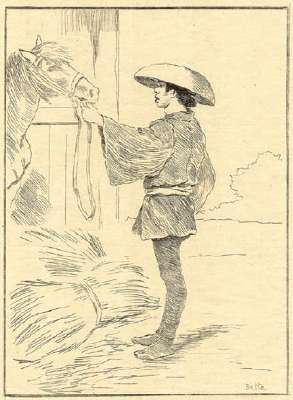
|
Plate 22
Jun_iki [Man in Straw Rain Gear]
13.4 x 18.8 cm
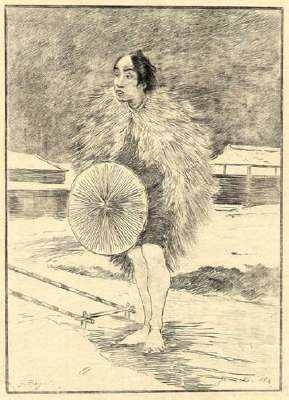
|
|
|
Plate 23
Pecheur [Man Fishing]
13.7 x 18.5 cm

|
Plate 24
Ama [A Blind Masseuse]
12.1 x 18.6 cm
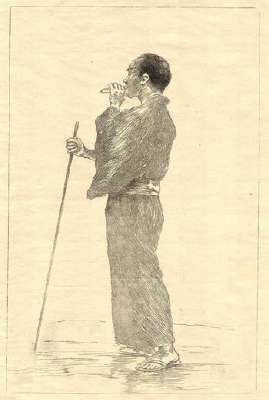
|
|
|
Plate 25
M. de Poissons [Fish Monger/Merchant]
13.4 x 18.8 cm

|
Plate 26
[Man With Basket - Cleaning a Road/Path]
12.1 x 18.8 cm

|
|
|
Plate 27
M. de Pueta [Traveling Shoe Merchant/Seller]
13.2 x 19.1 cm
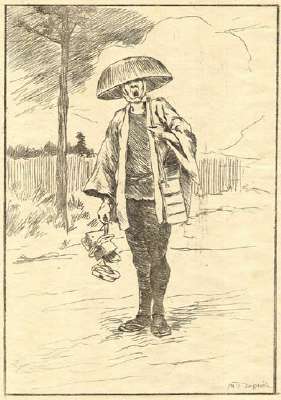
|
Plate 28
Chanteuses des Rue [Two Street Singers]
13.3 x19 cm
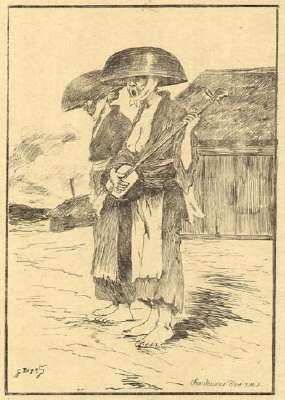
|
|
|
Plate 29
[View of Pond and Structures]
11.9 x 16.3 cm
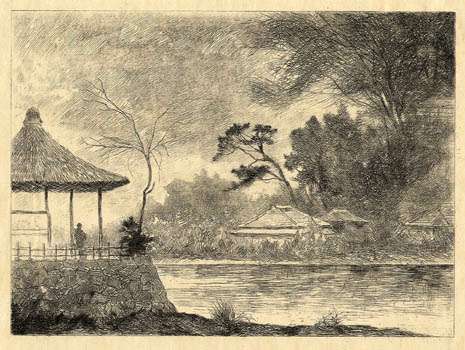
|
|
|
Back Cover - Tipped on Etching
16.4 x 17.5 cm
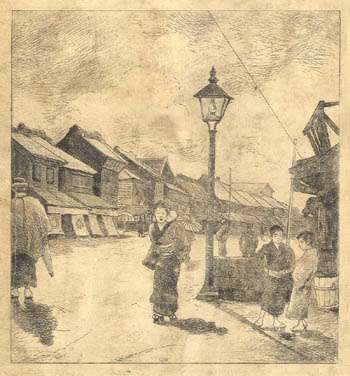
Identified as "Rue de Kojimachi a Tokyo" (1987 Bigot Exhibition).
|
Georges Bigot

(1860-1927)
Georges Bigot, a French painter and sketch artist, resided in Japan from 1882-1899. Initially he taught drawing at the National Military Academy. He married in Japan and had a son, Maurice. Georges Bigot and Charles Wirgman (See The Japan Punch) are both noted for their satirical sketch art in Japan. In Japan, Bigot's art appeared in a number of works. It is said that he published over 30 books/albums with his sketch art. Additionally, it is believed that he published or contributed to over 100 different periodicals (most in Japan and a few in Europe). It has been reported that Bigot was engaged in amateur photography in Japan but I have found no photographic images attributed to him recorded in publications or offered on the market. In 1899 he divorced his wife, Masu, and departed Japan with his son. He returned to France where he remarried and began a career producing satirical drawings (Epinal prints), sketches for magazines and later landscape paintings. Many of the landscapes were of Japanese scenes. For a listing of books and periodicals associated with Georges Bigot, click here. Two recent articles regarding Georges Bigot are outlined below.
Bigot's work in Japan was multi-faceted. He produced individual works for patrons, very limited edition books of etchings and mass marketed works in lithograph form. He worked in several mediums (water color paintings, sketches, etchings and lithographs) across a wide spectrum of subjects. He lived in Japan during an era of rapid modernization and assimilation of Western technology, ideas, values and styles. Much of his work appears to be an effort to capture images of the old pre-modernization Japan. On the other hand, he was keenly aware of where Japan was headed and sought to show that in his work. These images tend to be more in the nature of satire and along the line of what we now call cartoons.
In art published in France, Bigot would sometimes add the following Japanese signature to his work:

Books and Articles on Georges Bigot.
1987 - Bigot Exhibition in Japan and Paris
Georges Bigot: Ill y a cent ansa, nun artiste Francis auk Japan, Tokyo, Reunion desk Musees Japonais and Journal Yomiuri, 1987, square 8vo (9 x 9 1/2 in - 23 x 24 cm), text in Japanese and French, soft wraps, front cover illustrated with Bigot painting of a young lady carrying a child, 773 numbered illustrations of Bigot's work, 198 pp. An exhibition catalogue. This exhibition toured Japan and Paris from March through October of 1987. The catalogue is divided into two parts - works in color (386 numbered illustrations) and works in black and white (387 numbered illustrations).Often a numbered illustration contains sub-parts so there are far more than the 773 numbered illustrations. At the back are two sections with notes on each numbered illustration. The color illustrations show Bigot's works in Japan in water color, oil on canvas and pen & ink. The black and white illustrations show Bigot's sketch work as depicted in actual drawings or contained in various published formats (etchings, reproduced in lithograph and photo-mechanically reproduced). While Bigot's work before and after Japan are shown in this part, the vast majority are from the period when he lived in Japan. The black and white section also reproduces 6 photographs (#339) which appear to be his wife and son. A important and richly illustrated listing of Georges Bigot work in Japan. To see the cover, click here.
2002 - Daruma, Georges Bigot Article (Epinal Prints)
Available - Purchase Here
Shigeru, Oikawa:
Georges Bigot's Secret Life as an Epinal Print Artist, published in Daruma, Japanese Art & Antiques Magazine, Issue 33, Vol. 9, No. 1, Winter 2002, Japan, 8vo, illustrated stiff wraps, 58 pp. The article on Georges Bigot covers pages 37 to 46. It is illustrated with 18 figures. A discussion of Georges Bigot's work after he returned to France in 1899. The "Epinal Prints" were color lithographs of a cartoon type nature presenting short stories/tales. They received the name because they were produced by the Jean-Charles Pellerin in the town of Epinal in France. Many of the prints were anonymous but Bigots name or identification is contained in some. Many but not all of the Bigot prints depict Japanese scenes. Other articles in this issue deal with Maki-e lacquer items, Netsuke carvers and Namikawa Sosuke. To see the cover of this issue, click here.
2002 - Daruma, Georges Bigot Article
Available - Purchase Here
Tamio, Ikeda
Gallery Tamakaya (illustrations):
Georges Bigot's Passion for Japan, published in Daruma, Japanese Art & Antiques Magazine, Issue 35, Vol. 9, No. 3, Summer 2002, Japan, 8vo, illustrated stiff wraps, 58 pp. The article on Georges Bigot covers pages 38 to 45. It is illustrated with 16 images. An informative and finely illustrated discussion of the French artist, Georges Bigot, with the primary focus on the 17+ years (1882-1899) he spent in Japan. An important reference work for the collector of Bigot's work. Several of the illustrations reflect Bigot's work in the satirical "Toba-e" form of sketch art. Other articles in this issue deal with Japanese Combs and Hairpins and Japanese Ceramic Tea Jars. To see the cover of this issue, click here.
2001 & 2003 - Japanese Books on Georges Bigot
Shimizu, Isao (editor):
Bigo Sobyoshu, Iwanami Bunko (2003) and Zoku Bigo Sobyoshu, Iwanami Bunko (2001), Tokyo, Iwanami Shoten.
2002 - Georges Bigot, French Artist in Japan
Images de L'ere -- Le Monde de Georges Bigot, un Artiste Francqis au Japon, ("Images of the Meiji Era - The World of Georges Bigot, a French Artist in Japan"), 2002, Kawasaki, Japan, Yamakawa Company, 4to, soft cover with illustrated dust jacket, 192 pp. Extensively illustrated in color and black and white. Covers Bigot's works in France before and after 20 years in Japan as well as his books, drawings, sketches and paintings while in Japan. Also provides biographical information on Bigot. In Japanese except for some captions to images which also include the English translation. A comprehensive review of Bigots work including his paintings, drawings (many published in The Graphic, La Vie Moderne and Journal des Voyages), satirical art and books. To see the dust jacket, click here. ISBN 4-634-60590-2.
|




































